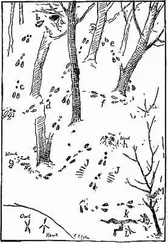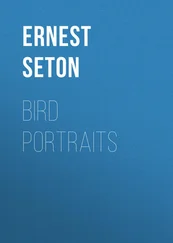Ernest Seton - Rolf in the Woods
Здесь есть возможность читать онлайн «Ernest Seton - Rolf in the Woods» весь текст электронной книги совершенно бесплатно (целиком полную версию без сокращений). В некоторых случаях можно слушать аудио, скачать через торрент в формате fb2 и присутствует краткое содержание. Год выпуска: 1997, Жанр: Приключения про индейцев, Исторические приключения, на английском языке. Описание произведения, (предисловие) а так же отзывы посетителей доступны на портале библиотеки ЛибКат.
- Название:Rolf in the Woods
- Автор:
- Жанр:
- Год:1997
- ISBN:нет данных
- Рейтинг книги:3 / 5. Голосов: 1
-
Избранное:Добавить в избранное
- Отзывы:
-
Ваша оценка:
- 60
- 1
- 2
- 3
- 4
- 5
Rolf in the Woods: краткое содержание, описание и аннотация
Предлагаем к чтению аннотацию, описание, краткое содержание или предисловие (зависит от того, что написал сам автор книги «Rolf in the Woods»). Если вы не нашли необходимую информацию о книге — напишите в комментариях, мы постараемся отыскать её.
Rolf in the Woods — читать онлайн бесплатно полную книгу (весь текст) целиком
Ниже представлен текст книги, разбитый по страницам. Система сохранения места последней прочитанной страницы, позволяет с удобством читать онлайн бесплатно книгу «Rolf in the Woods», без необходимости каждый раз заново искать на чём Вы остановились. Поставьте закладку, и сможете в любой момент перейти на страницу, на которой закончили чтение.
Интервал:
Закладка:
It was not truly dry for two or three days and as it tightened on its frame it gave forth little sounds of click and shrinkage that told of the strain the tensioned rawhide made. Quonab tried it that night as he sat by the fire softly singing:
"Ho da ho-he da he."
But the next day before sunrise he climbed the hill and sitting on the sun-up rock he hailed the Day God with the invocation, as he had not sung it since the day they left the great rock above the Asalnuk, and followed with the song:
"Father, we thank thee; We have found the good hunting. There is meat in the wigwam."
Chapter 22.
The Line of Traps
Now that they had the cabin for winter, and food for the present, they must set about the serious business of trapping and lay a line of deadfalls for use in the coming cold weather. They were a little ahead of time, but it was very desirable to get their lines blazed through the woods in all proposed directions in case of any other trapper coming in. Most fur-bearing animals are to be found along the little valleys of the stream: beaver, otter, mink, muskrat, coon, are examples. Those that do not actually live by the water seek these places because of their sheltered character and because their prey lives there; of this class are the lynx, fox, fisher, and marten that feed on rabbits and mice. Therefore a line of traps is usually along some valley and over the divide and down some other valley back to the point of beginning.
So, late in September, Rolf and Quonab, with their bedding, a pot, food for four days, and two axes, alternately followed and led by Skookum, set out along a stream that entered the lake near their cabin. A quarter mile up they built their first deadfall for martens. It took them one hour and was left unset. The place was under a huge tree on a neck of land around which the stream made a loop. This tree they blazed on three sides. Two hundred yards up another good spot was found and a deadfall made. At one place across a neck of land was a narrow trail evidently worn by otters. "Good place for steel trap, bime-by," was Quonab's remark.
From time to time they disturbed deer, and in a muddy place where a deer path crossed the creek, they found, among the numerous small hoof prints, the track of wolves, bears, and a mountain lion, or panther. At these little Skookum sniffed fearsomely, and showed by his bristly mane that he was at least much impressed.
After five hours' travel and work they came to another stream joining on, and near the angle of the two little valleys they found a small tree that was chewed and scratched in a remarkable manner for three to six feet up. "Bear tree," said Quonab, and by degrees Rolf got the facts about it.
The bears, and indeed most animals, have a way of marking the range that they consider their own. Usually this is done by leaving their personal odour at various points, covering the country claimed, but in some cases visible marks are added. Thus the beaver leaves a little dab of mud, the wolf scratches with his hind feet, and the bear tears the signal tree with tooth and claw. Since this is done from time to time, when the bear happens to be near the tree, it is kept fresh as long as the region is claimed. But it is especially done in midsummer when the bears are pairing, and helps them to find suitable companions, nor all are then roaming the woods seeking mates; all call and leave their mark on the sign post, so the next bear, thanks to his exquisite nose, can tell at once the sex of the bear that called last and by its track tell which way it travelled afterward.
In this case it was a bear's register, but before long Quonab showed Rolf a place where two long logs joined at an angle by a tree that was rubbed and smelly, and showed a few marten hairs, indicating that this was the sign post of a marten and a good place to make a deadfall.
Yet a third was found in an open, grassy glade, a large, white stone on which were pellets left by foxes. The Indian explained:
"Every fox that travels near will come and smell the stone to see who of his kind is around, so this is a good place for a fox-trap; a steel trap, of course, for no fox will go into a deadfall."
And slowly Rolf learned that these habits are seen in some measure in all animals; yes, down to the mice and shrews. We see little of it because our senses are blunt and our attention untrained; but the naturalist and the hunter always know where to look for the four-footed inhabitants and by them can tell whether or not the land is possessed by such and such a furtive tribe.
Chapter 23.
The Beaver Pond
AT THE noon halt they were about ten miles from home and had made fifteen deadfalls for marten, for practice was greatly reducing the time needed for each.
In the afternoon they went on, but the creek had become a mere rill and they were now high up in a more level stretch of country that was more or less swampy. As they followed the main course of the dwindling stream, looking ever for signs of fur-bearers, they crossed and recrossed the water. At length Quonab stopped, stared, and pointed at the rill, no longer clear but clouded with mud. His eyes shone as he jerked his head up stream and uttered the magic word, "Beaver."
They tramped westerly for a hundred yards through a dense swamp of alders, and came at last to an irregular pond that spread out among the willow bushes and was lost in the swampy thickets. Following the stream they soon came to a beaver dam, a long, curving bank of willow branches and mud, tumbling through the top of which were a dozen tiny streams that reunited their waters below to form the rivulet they had been following.
Red-winged blackbirds were sailing in flocks about the pond; a number of ducks were to be seen, and on a dead tree, killed by the backed up water, a great blue heron stood. Many smaller creatures moved or flitted in the lively scene, while far out near the middle rose a dome-like pile of sticks, a beaver lodge, and farther three more were discovered. No beaver were seen, but the fresh cut sticks, the floating branches peeled of all the bark, and the long, strong dam in good repair were enough to tell a practised eye that here was a large colony of beavers in undisturbed possession.
In those days beaver was one of the most valued furs. The creature is very easy to trap; so the discovery of the pond was like the finding of a bag of gold. They skirted its uncertain edges and Quonab pointed out the many landing places of the beaver; little docks they seemed, built up with mud and stones with deep water plunge holes alongside. Here and there on the shore was a dome-shaped ant's nest with a pathway to it from the pond, showing, as the Indian said, that here the beaver came on sunny days to lie on the hill and let the swarming ants come forth and pick the vermin from their fur. At one high point projecting into the still water they found a little mud pie with a very strong smell; this, the Indian said, was a "castor cache," the sign that, among beavers, answers the same purpose as the bear tree among bears.
Although the pond seemed small they had to tramp a quarter of a mile before reaching the upper end and here they found another dam, with its pond. This was at a slightly higher level and contained a single lodge; after this they found others, a dozen ponds in a dozen successive rises, the first or largest and the second only having lodges, but all were evidently part of the thriving colony, for fresh cut trees were seen on every side. "Ugh, good; we get maybe fifty beaver," said the Indian, and they knew they had reached the Promised Land.
Rolf would gladly have spent the rest of the day exploring the pond and trying for a beaver, when the eventide should call them to come forth, but Quonab said, "Only twenty deadfall; we should have one hundred and fifty." So making for a fine sugar bush on the dry ground west of the ponds they blazed a big tree, left a deadfall there, and sought the easiest way over the rough hills that lay to the east, in hopes of reaching the next stream leading down to their lake.
Читать дальшеИнтервал:
Закладка:
Похожие книги на «Rolf in the Woods»
Представляем Вашему вниманию похожие книги на «Rolf in the Woods» списком для выбора. Мы отобрали схожую по названию и смыслу литературу в надежде предоставить читателям больше вариантов отыскать новые, интересные, ещё непрочитанные произведения.
Обсуждение, отзывы о книге «Rolf in the Woods» и просто собственные мнения читателей. Оставьте ваши комментарии, напишите, что Вы думаете о произведении, его смысле или главных героях. Укажите что конкретно понравилось, а что нет, и почему Вы так считаете.




